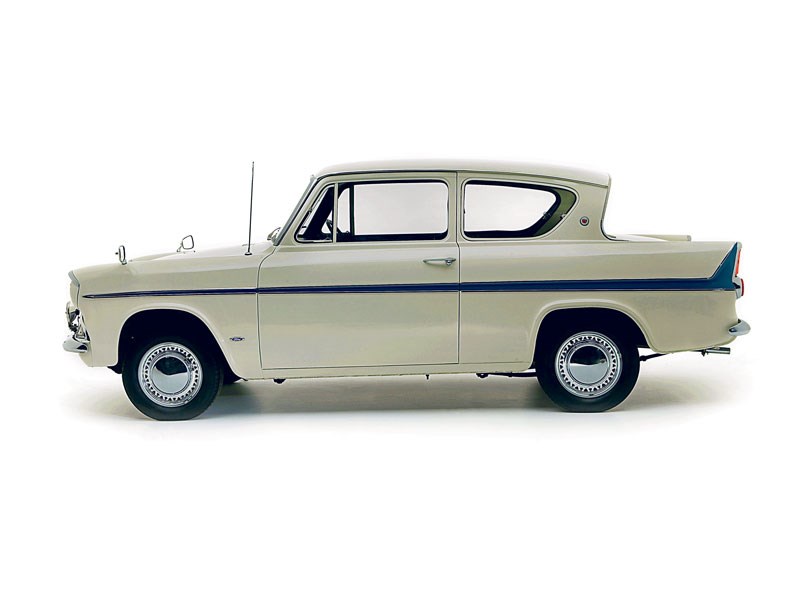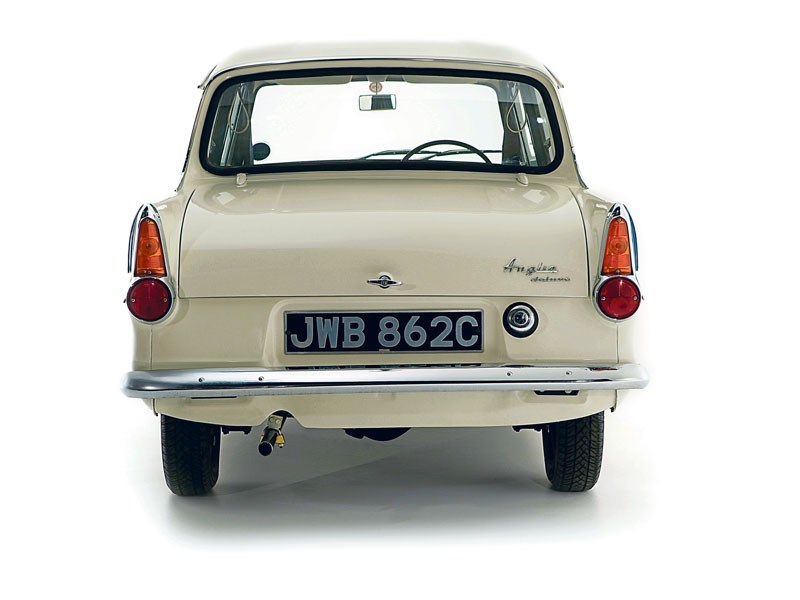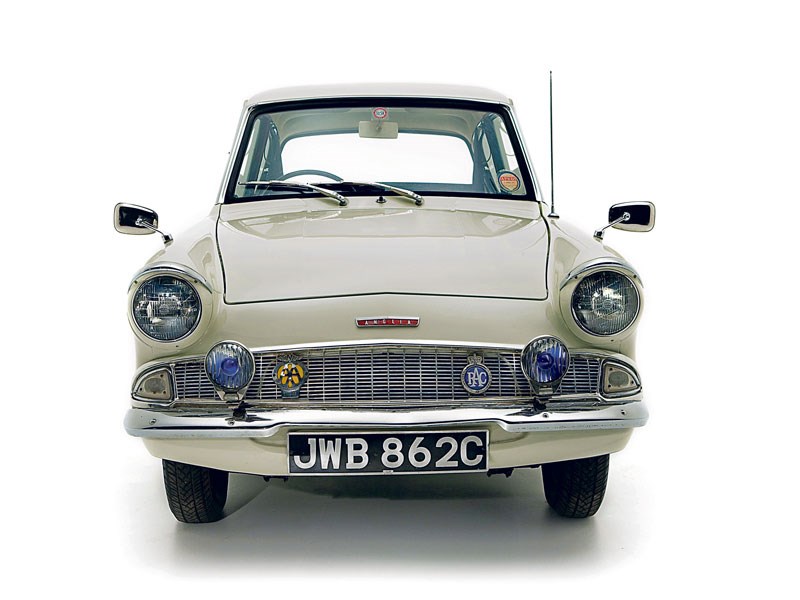Rakish style and bags of character – Dagenham’s darling has huge appeal...
If you’re in the market for a small 1960s saloon, you wont go far wrong with an Anglia 105E. The 997cc four-cylinder engine is frugal and easy to work on, and while it won’t set the world alight with its performance, it makes the car a usable everyday classic that can easily hold its own in modern traffic in most conditions.
The engine is surprisingly capable, but needs to be revved to get the most out of it. This makes the 105E feel very peppy and engaging to drive. The gearbox provides a smooth and assured gear change – four speeds being adequate for everything other than extended motorway driving. The brakes take a bit of getting used to, but easily slow the Anglia thanks to its low kerbweight, which will also leave few owners wishing for power steering – perfect for those who find larger classics difficult to manage.
All-round visibility is terrific, with the large windows affording the driver an unimpeded and panoramic view of the road ahead. The 105E is great all-rounder and a real charmer, which explains its ongoing popularity since 1959.
VITAL STATISTICS
1960 Ford Anglia 105E
Engine 997cc/4-cyl/OHV
Power (bhp@rpm) 39bhp@5000rpm
Torque (lb ft@rpm) 55ft lb ft@2700rpm
Top speed 73mph
0-60mph 26.9sec
Consumption 41mpg
WHAT TO LOOK FOR
BODYWORK & CHASSIS
Wings will rust at their trailing edge, and if they are gone, then the A-pillar behind is likely to be in bad shape, too. Rear arches are usually fine, but rear wings will crumble between the wheelarch and lower bumper. Behind the front numberplate is a water trap, so feel behind for loose rust. The lower front valance will corrode at either end; rear valances are connected to the crossmember by four pop-rivets and will rust in cars that aren’t kept clean. Doors will start to decay around the frame and in the centre below the rear quarter light. Replacement panels can cost up to £400, but repair sections are cheap. Front and rear wings are rarely beyond repair.
Bonnets and boot lids will start to rust around their edges, with boots also rusting around the hinges. Boot floors will also corrode, so make sure you lift up the carpet and have a good poke around. Carefully check the area where the boot floor meets the rear panel – there is a drainage hole here that easily becomes blocked. The front headlights will rust at their peak, and rear lights can go if dirt and salt collects behind the chrome work. Windscreens rarely pose a problem, and rear screens stay dry for the most part, so both should be fine.
Sills will eventually succumb to corrosion – starting at the front, then the rear, then the middle. If sills are a mess in the middle then it is a sure sign the rest is in poor shape, perhaps poorly repaired or filled. Rust on the outer sills will also suggest that the inner membranes are rotten, so budget for replacement parts. If the sills seem sound, be sure to check that the drain hole to the front of the sill is clear – if not, it will lead to problems in the future.
ENGINE
The997cc engines will last for more than 100,000 miles, whereas 1.2-litre engines do well to make it to 70,000 miles without a re-build. Start the engine from cold at a fast idle and listen for any knocking. Take off the top of the rocker cover and start the engine from cold – walk away if it throws out oil or any amount of smoke. There’s no synchromesh on first gear on 997cc engine cars, so be aware of this if you’re taking a test drive. Gearboxes are rock solid – some have been known to make it to more than 325,000 miles – but you should make sure gear changes are precise and positive.
RUNNING GEAR
Front and rear crossmembers will eventually give up at either end where dirt collects, so make sure you take a good look behind each valance. Though not terribly expensive to repair, it is beyond the capability of the average amateur mechanic, and can be tricky to put right. Inner sills and jacking points will rust with time, but gearbox tunnels should be solid. Lift the rear seat squabs and look at the floorpan underneath. This is just above the rear jacking points, so should give you some indication of rust problems and previous repairs.
BRAKES
If we haven’t put you off already, there’s one more hidden area to examine for corrosion. This is the ledge on the bulkhead that supports the brake servo. Debris accumulates here and, especially if combined with leaking brake fluid, can cause the metal underneath to rot through.
INTERIOR
Interiors are basic and practical, with the majority being trimmed in vinyl. Some cars were finished in leather, but these attract no real price premium over standard interiors, so don’t pay extra for it. Full interior sets are easy enough to source and relatively cheap to refurbish if not in top condition.
OUR VERDICT
The 105E was the final Anglia and the result of the refinement and innovation of a model that had started life before WW2. Produced from 1959, the 105E sported rakish US-influenced styling that British cars had lacked up to that point. Gone were the smooth curves of the 100E, replaced by a backward slanting rear window and prominent headlamps. Testing in the wind tunnel resulted in a more shallow bonnet, with subtle tail fins added to give the impression of speed – a bold design choice.
The 105E also received a 997cc OHV straight-four engine, a long overdue addition to the Ford range. The engine produced 39bhp, a slight improvement in performance, but a giant leap in reliability.
Throughout its eight years of production, Ford built just over one million 105Es – 191,752 of these were in its first year, smashing Ford’s volume production record at the time. As well being an affordable car of the people, the 105E was also used extensively in motorsport. Ford was aware of the desire to tune cars long before their rivals, even producing a performance kit which cost £13.
The Anglia 105E has established a reputation for being the ideal starter classic, and it’s a reputation that is well deserved. They are very affordable, and almost any job can be attempted in your garage at home. A relatively plentiful supply of cars means parts are easy to come by, too, and a strong club following means there are plenty of summer events to keep you occupied. Huge popularity in the modifying community has resulted in a raft of performance upgrades to suit every budget and ensured that quality engines are still easy to get hold of.
As with most cars of this age, you can quickly spend a lot of money on restoration, so it pays to buy the best example you can find. It’s better to buy a car with proven history from a club member, as some project cars will be hiding serious problems and are likely to be much more expensive to repair than you budget for.


